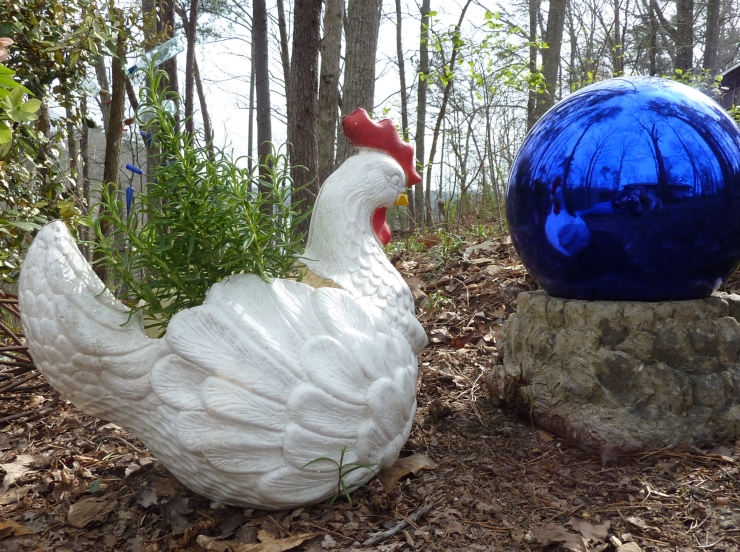
The need for this post came upon me as I was looking around the late winter garden at the lake. It was just a few weeks ago in early March. Everything was rather bare. Mottled green and maroon Trilliums were starting to open, pale gray-green Bellwort (Uvularia grandiflora) was beginning to bend softly over to assume its namesake shape; white and yellow star-flowered False Garlic (Nothoscordum bivalve) was blooming, and delicate Bluets (Houstonia caerulea) dotted the ground in small patches. And all of this was barely four inches off the ground. Other than that, though, there was no color other than shades of brown, ash gray, taupe, and umber. Having a rather clear stage, then, the eclectic collection of objects I have placed around the garden scape stood out like five-year-olds screaming “look at me!” And I did.
There is a large concrete gargoyle, a baby gargoyle with a broken wing, which I have since repaired, a rusting white metal deer that was once a Christmas decoration, and a little dog made out of scrap pieces of metal.
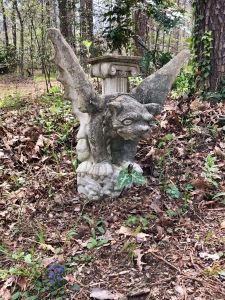
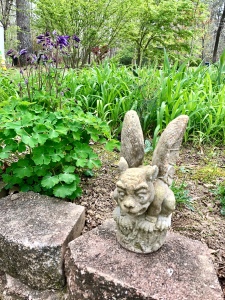
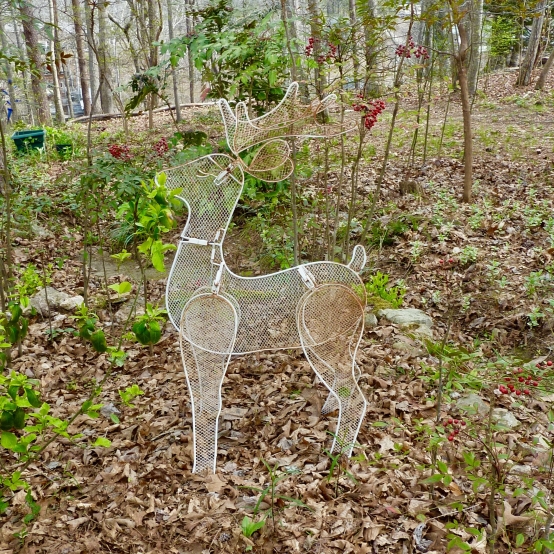

These photos were, as the columbine and azalea indicate, taken at varied times after that day in early March. And, their gallery does not exhaust the number of objects to be found throughout the garden. But, each made me consider what I would think about it—especially that rusting deer—if I were to see it in someone else’s garden. It was not a large leap, then, to thoughts about garden art and the difference between garden art and yard art.
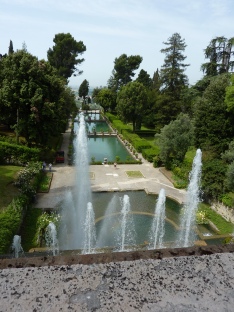 The academic in me turned to research beyond Google, so far, in fact, as interlibrary loan. Even before the books came in though, I knew that the differences between garden and yard art extend as far afield as the anthropological, economic, social, class, national, and horticultural differences range between gardens and yards, or for that matter among gardens and yards. Moreover, the liminal, the gray, space between them is nearly as broad. Scale alone presents so many variables and factors of consideration that architectural differences in landscape and hardscape make such an investigation more the topic of a dissertation, or a publisher’s series, than an aficionado’s blog post. The scale of Italy’s 16th-century Villa D’Este with its series of pools, or the size and symbolic placement of monuments such as the Temple of the British Worthies across the Elysian Fields from the Temple of Ancient Virtues in England Stowe’s or Rousham’s Pan in the Vale of Venus or The Dying Gaul, present a type of garden art, literally, of a singular class.
The academic in me turned to research beyond Google, so far, in fact, as interlibrary loan. Even before the books came in though, I knew that the differences between garden and yard art extend as far afield as the anthropological, economic, social, class, national, and horticultural differences range between gardens and yards, or for that matter among gardens and yards. Moreover, the liminal, the gray, space between them is nearly as broad. Scale alone presents so many variables and factors of consideration that architectural differences in landscape and hardscape make such an investigation more the topic of a dissertation, or a publisher’s series, than an aficionado’s blog post. The scale of Italy’s 16th-century Villa D’Este with its series of pools, or the size and symbolic placement of monuments such as the Temple of the British Worthies across the Elysian Fields from the Temple of Ancient Virtues in England Stowe’s or Rousham’s Pan in the Vale of Venus or The Dying Gaul, present a type of garden art, literally, of a singular class.

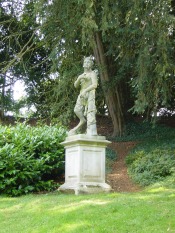

From my reading, though, I do want to pass along three works that enriched my understanding of garden art, one from the grand scale that in ways both conscious and unconscious we of less grand means mirror in our own gardens ,even as Italian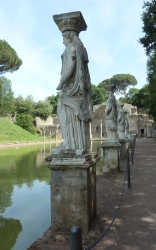 Renaissance architect Pirro Liggori who planned the pools at Villa d’Este may have been influenced by the pool in Emperor Hadrian’s second-century CE villa, also in Tivoli. What I refer to here is Marie Luise Gothein’s 2-volume work, A History of Garden Art, published first in German in 1913, and later in English in 1928. Don’t let the publication date put you off. This is a wonderfully erudite work that represents the best of early 20th-century scholarship, rich in content and in prose. Reading it is like having a conversation with a really smart, generous, and congenial woman who loves gardens and garden history as much as you do—and who has read widely.
Renaissance architect Pirro Liggori who planned the pools at Villa d’Este may have been influenced by the pool in Emperor Hadrian’s second-century CE villa, also in Tivoli. What I refer to here is Marie Luise Gothein’s 2-volume work, A History of Garden Art, published first in German in 1913, and later in English in 1928. Don’t let the publication date put you off. This is a wonderfully erudite work that represents the best of early 20th-century scholarship, rich in content and in prose. Reading it is like having a conversation with a really smart, generous, and congenial woman who loves gardens and garden history as much as you do—and who has read widely.
The second is from the other side of the spectrum, The Flamingo in the Garden: American Yard Art and the Vernacular Landscape, by Colleen J. Sheehy, published in 1998. The book is firmly situated in anthropological theory, presenting Sheehy’s ethnographic study of yards on the American east and west coast and in the mid-west and south, fully recognizing the “culturally charged, dense environment” they offer for interpretation (xiii). While she places the topic of yard art in the context of the larger vernacular landscape, a statement she makes in the very beginning of her introduction, gave me a jumping off place for thinking about garden/yard art.
Yard ornaments and statuary can express religious, ethnic, regional, and other affiliations. And they tell us about what people consider beautiful, for American yard art, at bottom, is about creating scenes of aesthetic pleasure and enjoyment (xii).
Sheehy also notes that the garden, like the yard also a cultural space, is an idealized space as well. Both of these points took me back to my own initial posts in After Eden. Posts about why we garden and what we attempt to create in—and out of—the garden. My gargoyles, rusting Christmas deer, and scrap metal dog tell observers little about what I consider beautiful, but they do suggest something about my ironic sense of aesthetic pleasure and enjoyment. I’ll return to the issue of the garden as an idealized space in a moment. First, I want to mention the third work that caught my attention, and the one that may have provided the most interesting bit of information.
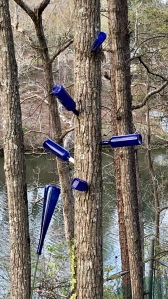 On encyclopedia.com, I found the following assertion about African American yardscaping:
On encyclopedia.com, I found the following assertion about African American yardscaping:
Items that some might call yard art not only decorate but display connections with the past and the staying power of forebears: old wheels, plows, sewing machines, bed heads, iron washing and cooking pots, stones, and even special roots, trees, and flowers like jonquils that return year after year, long after a home has been abandoned (“Garden and Yard Art,” Encyclopedia of African-American Culture and History).
This seems a better rationale for my Christmas deer than any expression of what I consider beautiful. And, it certainly resonates with my tendency to remember people by the plants they have given me for my garden. Moreover, it also reminded me of the beginning of my fascination of with bottle trees—a garden tradition that can be traced to the West African Coast. In the short story that carries her name, I learned from Eudora Welty’s Livvie, that “there could be a spell put in trees, and [Livvie] was familiar from the time she was born with the way bottle trees kept evil spirits from coming into the house.” There are no evil spirits getting into my house!
This all comes together to say, what appears in my garden appears in my ever-emerging idealized space. Everything has a significance for me that most other people could never be expected to intuit. The perfect example is the “gazing chicken” that appears in the featured photo of this post. Over 20 years ago I mentioned to my mother that I was going to get a Victorian gazing ball for the garden. She was horrified. I’m not sure why, but she was. So, I bought the cheapest garden ornament I could find, this plastic chicken planter, and told her I did not have a Victorian gazing ball, but an American gazing chicken. With rosemary planted in it, as in this photo, I guess I have a gazing rosemary chicken.
Snow Bear provides a closing example of garden art that carries greater significance than the function or appearance of its physical form would suggest. In a yard near my parents’ home in Baltimore County, there was a concrete bench in the shape of a bear, painted like a polar bear with a big black nose. I always thought a cement polar bear on a front yard in Baltimore was rather amusing. Then, while on the way back from a road trip to Michigan I saw a concrete bear bench in a garden ornament shop in Indiana, and had to have him. We are fortunate that we did not break an axle on the journey back to Birmingham. These things are heavy. But, now I have a bear bench in Alabama, standing among hellebores, camellias, and pine trees on snow made of white stones and refreshing himself with some blue glass ice.
This, to me, is even more amusing than the painted polar bear in Baltimore. I wonder, though, what a passerby on a road over a ridge in the foothills of the Appalachian Mountains in Blount County, Alabama, thinks of a concrete bench in the shape of a bear. To me, it is the neighborhood of my teenage years in Baltimore County, Maryland; it is a road trip to visit a much-loved friend in Traverse City, Michigan; it is the claiming of a garden spot in Highland Lake, Alabama, as uniquely mine; it is also a surprisingly pleasing bench from which to look down through the trees, shrubs, and perennials to the lake.
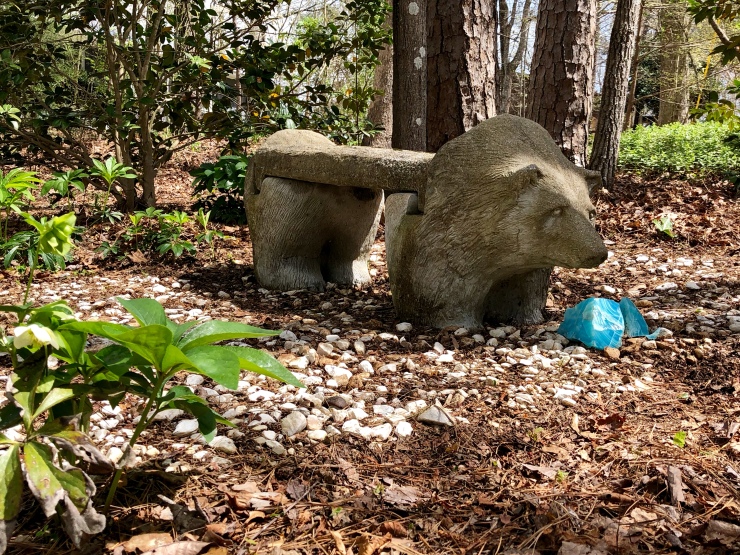
© Susan K. Hagen and After Eden, 2018

Interesting, Susan. On my walks I will now look at yard art from the perspective you describe. And I like that bench!
LikeLiked by 1 person
But do gardeners actually sit on their benches? I know I never could when I had a big garden to care for; the moment I sat down to survey the scene, I’d see something that needed doing and would be running off for my trowel or my cutting shears. Your informative commentary on what, anthropologically speaking, makes yard art makes me think of the way my friends in England always correct me whenever I use the words “front yard” or “back yard” to refer to the greensward that borders a home. A “yard,” they insist, is an alley, usually urban, often pejorative, and not a nice thing to call something around a home at all.
LikeLike
Well, I don’t think we sit on those benches for any extended period of time. Moreover, while I am sitting, I am planning.
LikeLike
This time every year I have a hankering to visit Jasmine Hills Gardens in Wetumpka. Talk about garden art! Your blog post reminds me that now is the perfect time to go!
LikeLiked by 1 person
Jasmine Hills is on my list for later this spring or summer, too.
LikeLike
Oh my! I just wrote about bad garden art, particularly a bronzed lawn mower!
LikeLike